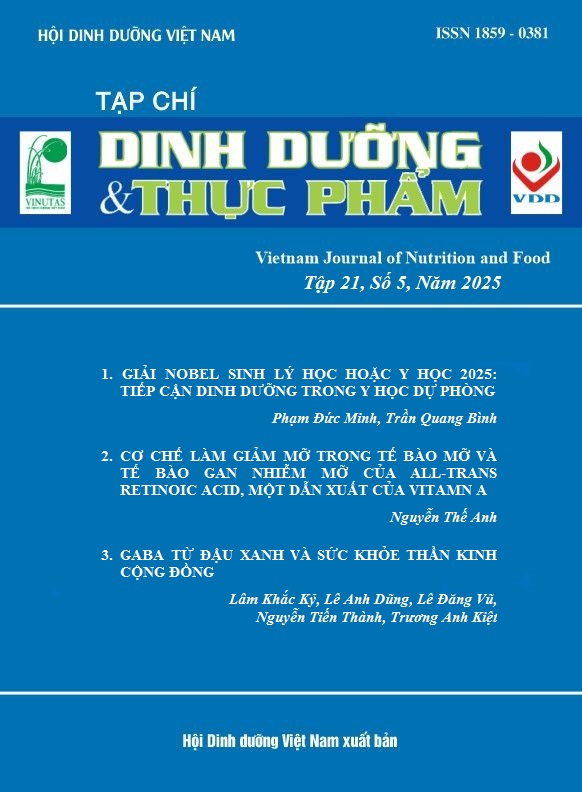THE MECHANISM OF ALL-TRANS RETINOIC ACID ON FAT REDUCTION IN ADIPOCYTES AND FATTY HEPATOCYTES
Main Article Content
Abstract
Obesity has been a health burden and it is estimated that by 2030, more than one billion adults worldwide will be obese. Accumulation of triglyceride as fat droplets in adipose tissue (hypertrophy) and liver cells (non-alcoholic fatty liver disease – NAFLD) is a hallmark of obesity. Lipases are involved in the breakdown of fat droplets, known as the canonical pathway, in addition to a newly discovered pathway, called lipophagy.
All-trans Retinoic Acid (atRA) is a vitamin A derivative that has been shown to increase lipolysis in adipocytes via the canonical pathway, however the effect of atRA on lipophagy is currently under investigation. Research has shown that atRA enhances lipolysis by enhancing lipophagy by activating the AMPK-Beclin1 signaling pathway in adipocytes. At the same time, atRA was shown to also enhance lipophagy through down-regulation of Rubicon protein expression – a negative regulator of autophagy. atRA promises to play an important role in future obesity treatment strategies.
Keywords
Obesity, lipolysis, atRA, lipophagy, Rubicon.
Article Details
References
2. WHO. 2023. WHO acceleration plan to stop obesity. WHO. Geneva, Switzerland. [Cited 10 July 2024]. https://www.who.int/publications/i/item/9789240075634.
3. UNICEF. Children in viet nam. 2020. Accessed September 5, 2025. https://www.unicef.org/media/101246/file/Vietnam-2020-COAR.pdf.
4. Khan NC, Khoi HH. Double burden of malnutrition: the Vietnamese perspective. PubMed. 2008;(17 (S1)):116-118.
5. Van Minh H, Khuong DQL, Tran TA, Do HP, Watson F, Lobstein T. Childhood Overweight and Obesity in Vietnam: A Landscape Analysis of the Extent and Risk Factors. INQUIRY: The Journal of Health Care Organization, Provision, and Financing. 2023;60:004695802311546.
6. Zhang X, Ha S, Lau HCH, Yu J. Excess body weight: Novel insights into its roles in obesity comorbidities. Seminars in Cancer Biology. 2023;92:16-27.
7. Maerjianghan Abuduli, Hirokazu Ohminami, Otani T, et al. Effects of dietary phosphate on glucose and lipid metabolism. AJP Endocrinology and Metabolism. 2016;310(7):E526-E538.
8. Masuda M, Yoshida-Shimizu R, Mori Y, et al. Sulforaphane induces lipophagy through the activation of AMPK-mTOR-ULK1 pathway signaling in adipocytes. The Journal of Nutritional Biochemistry. 2022;106:109017-109017.
9. Berry DC, Noy N. All- trans -Retinoic Acid Represses Obesity and Insulin Resistance by Activating both Peroxisome Proliferation-Activated Receptor β/δ and Retinoic Acid Receptor. Molecular and Cellular Biology. 2009;29(12):3286-3296.
10. Zechner R, Kienesberger PC, Haemmerle G, Zimmermann R, Lass A. Adipose triglyceride lipase and the lipolytic catabolism of cellular fat stores. Journal of Lipid Research. 2008;50(1):3-21.
11. Singh R, Kaushik S, Wang Y, et al. Autophagy regulates lipid metabolism. Nature. 2009;458(7242):1131-1135.
12. Shibutani ST, Yoshimori T. A current perspective of autophagosome biogenesis. Cell Research. 2013;24(1):58-68.
13. Orfali N, O’Donovan TR, Nyhan MJ, et al. Induction of autophagy is a key component of all-trans-retinoic acid-induced differentiation in leukemia cells and a potential target for pharmacologic modulation. Experimental Hematology. 2015;43(9):781-793.e2.
14. Zhou GB, Zhang J, Wang ZY, Chen SJ, Chen Z. Treatment of acute promyelocytic leukaemia with all-trans retinoic acid and arsenic trioxide: a paradigm of synergistic molecular targeting therapy. Philos Trans R Soc Lond B Biol Sci. 2007;362(1482):959-971.
15. Liu Y, Chen H, Mu D, et al. Circulating Retinoic Acid Levels and the Development of Metabolic Syndrome. The Journal of Clinical Endocrinology and Metabolism. 2016;101(4):1686-1692.
16. Horwitz A, Birk R. Adipose Tissue Hyperplasia and Hypertrophy in Common and Syndromic Obesity-The Case of BBS Obesity. Nutrients. 2023;15(15):3445. Doi: 10.3390/nu15153445.
17. Kopelman PG. Obesity as a medical problem. Nature. 2000;404(6778):635-643.
18. Yoshii SR, Mizushima N. Monitoring and Measuring Autophagy. International Journal of Molecular Sciences. 2017;18(9):1865. doi: 10.3390/ijms18091865.
19. Ye X, Zhou XJ, Zhang H. Exploring the Role of Autophagy-Related Gene 5 (ATG5) Yields Important Insights Into Autophagy in Autoimmune/Autoinflammatory Diseases. Frontiers in Immunology. 2018;9:2334. doi: 10.3389/fimmu.2018.02334.
20. Kim J, Kundu M, Viollet B, Guan KL. AMPK and mTOR regulate autophagy through direct phosphorylation of Ulk1. Nature Cell Biology. 2011;13(2):132-141.
21. Mashek DG. Hepatic lipid droplets: A balancing act between energy storage and metabolic dysfunction in NAFLD. Mol Metab. 2021;50:101115. doi: 10.1016/j.molmet.2020.101115.
22. Anstee QM, Targher G, Day CP. Progression of NAFLD to diabetes mellitus, cardiovascular disease or cirrhosis. Nature Reviews Gastroenterology & Hepatology. 2013;10(6):330-344.
23. Fabbrini E, Sullivan S, Klein S. Obesity and nonalcoholic fatty liver disease: Biochemical, metabolic, and clinical implications. Hepatology. 2010;51(2):679-689.
24. Wang S, Feng R, Shi Y, et al. Intracellular alpha-fetoprotein interferes with all-trans retinoic acid induced ATG7 expression and autophagy in hepatocellular carcinoma cells. Scientific Reports. 2021;11(1). doi: 10.1038/s41598-021-81678-7.
25. Seong Chul Kim, Chun Ki Kim, Axe D, et al. All-trans-retinoic acid ameliorates hepatic steatosis in mice by a novel transcriptional cascade. Hepatology. 2014;59(5):1750-1760.
26. Asare N, Tekpli X, Rissel M, et al. Signalling pathways involved in 1-nitropyrene (1-NP)-induced and 3-nitrofluoranthene (3-NF)-induced cell death in Hepa1c1c7 cells. Mutagenesis. 2009;24(6):481-493.
27. N. Podechard, X. Tekpli, D. Catheline, et al. Mechanisms involved in lipid accumulation and apoptosis induced by 1-nitropyrene in Hepa1c1c7 cells. Toxicology Letters. 2011;206(3):289-299.
28. Tanaka S, Hikita H, Tatsumi T, et al. Rubicon inhibits autophagy and accelerates hepatocyte apoptosis and lipid accumulation in nonalcoholic fatty liver disease in mice. Hepatology. 2016;64(6):1994-2014.
29. Matsunaga K, Saitoh T, Tabata K, et al. Two Beclin 1-binding proteins, Atg14L and Rubicon, reciprocally regulate autophagy at different stages. Nature Cell Biology. 2009;11(4):385-396.
30. Bhargava HK, Tabata K, Byck JM, et al. Structural basis for autophagy inhibition by the human Rubicon–Rab7 complex. Proceedings of the National Academy of Sciences. 2020;117(29):17003-17010.
31. Tadashi Yamamuro, Nakamura S, Yanagawa K, et al. Loss of RUBCN/rubicon in adipocytes mediates the upregulation of autophagy to promote the fasting response. Autophagy. 2022;18(11):2686-2696.
32. Mori Y, Masuda M, Yoshida-Shimizu R, et al. All-trans retinoic acid induces lipophagy through the activation of the AMPK-Beclin1 signaling pathway and reduces Rubicon expression in adipocytes. J Nutr Biochem. 2024;126:109589. doi: 10.1016/j.jnutbio.2024.109589.
33. Yamamoto H, Zhang S, Mizushima N. Autophagy genes in biology and disease. Nat Rev Genet. 2023;24(6):382-400.


